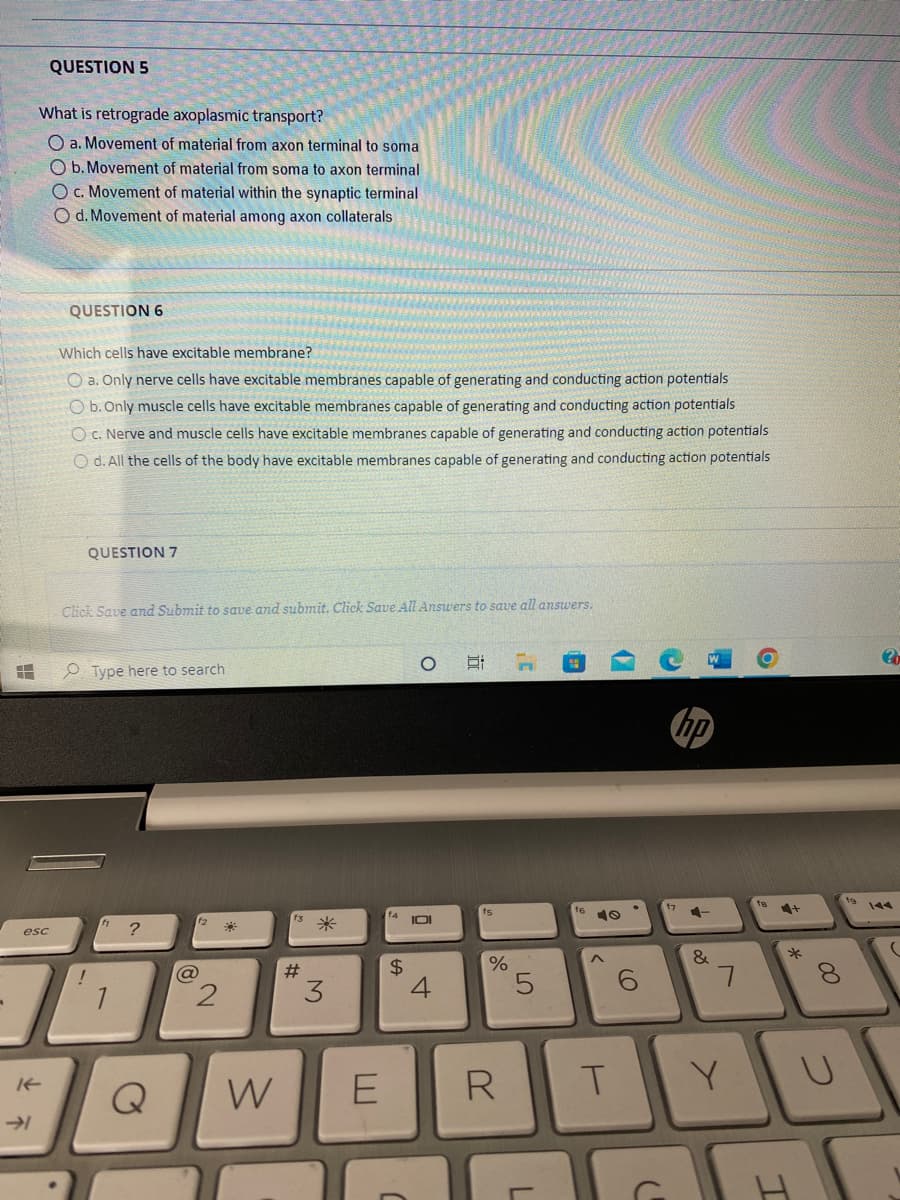QUESTION 5 What is retrograde axoplasmic transport? Oa. Movement of material from axon terminal to soma O b. Movement of material from soma to axon terminal Oc. Movement of material within the synaptic terminal O d. Movement of material among axon collaterals
QUESTION 5 What is retrograde axoplasmic transport? Oa. Movement of material from axon terminal to soma O b. Movement of material from soma to axon terminal Oc. Movement of material within the synaptic terminal O d. Movement of material among axon collaterals
Human Anatomy & Physiology (11th Edition)
11th Edition
ISBN:9780134580999
Author:Elaine N. Marieb, Katja N. Hoehn
Publisher:Elaine N. Marieb, Katja N. Hoehn
Chapter1: The Human Body: An Orientation
Section: Chapter Questions
Problem 1RQ: The correct sequence of levels forming the structural hierarchy is A. (a) organ, organ system,...
Related questions
Question

Transcribed Image Text:#
QUESTION 5
esc
It
What is retrograde axoplasmic transport?
O a. Movement of material from axon terminal to soma
O b. Movement of material from soma to axon terminal
Oc. Movement of material within the synaptic terminal
O d. Movement of material among axon collaterals
→
QUESTION 6
Which cells have excitable membrane?
O a. Only nerve cells have excitable membranes capable of generating and conducting action potentials
O b. Only muscle cells have excitable membranes capable of generating and conducting action potentials
O c. Nerve and muscle cells have excitable membranes capable of generating and conducting action potentials
Od. All the cells of the body have excitable membranes capable of generating and conducting action potentials
7
QUESTION 7
Click Save and Submit to save and submit. Click Save All Answers to save all answers.
Type here to search
?
(@
12
2
*
W
#
3
E
f4
$
J
O Ei
IOI
4
fs
%
R
5
T
40
<
(O
T
f
hp
4-
&
+
Y
TH
00
U
fo
?
(
Expert Solution
This question has been solved!
Explore an expertly crafted, step-by-step solution for a thorough understanding of key concepts.
Step by step
Solved in 2 steps

Knowledge Booster
Learn more about
Need a deep-dive on the concept behind this application? Look no further. Learn more about this topic, biology and related others by exploring similar questions and additional content below.Recommended textbooks for you

Human Anatomy & Physiology (11th Edition)
Biology
ISBN:
9780134580999
Author:
Elaine N. Marieb, Katja N. Hoehn
Publisher:
PEARSON

Biology 2e
Biology
ISBN:
9781947172517
Author:
Matthew Douglas, Jung Choi, Mary Ann Clark
Publisher:
OpenStax

Anatomy & Physiology
Biology
ISBN:
9781259398629
Author:
McKinley, Michael P., O'loughlin, Valerie Dean, Bidle, Theresa Stouter
Publisher:
Mcgraw Hill Education,

Human Anatomy & Physiology (11th Edition)
Biology
ISBN:
9780134580999
Author:
Elaine N. Marieb, Katja N. Hoehn
Publisher:
PEARSON

Biology 2e
Biology
ISBN:
9781947172517
Author:
Matthew Douglas, Jung Choi, Mary Ann Clark
Publisher:
OpenStax

Anatomy & Physiology
Biology
ISBN:
9781259398629
Author:
McKinley, Michael P., O'loughlin, Valerie Dean, Bidle, Theresa Stouter
Publisher:
Mcgraw Hill Education,

Molecular Biology of the Cell (Sixth Edition)
Biology
ISBN:
9780815344322
Author:
Bruce Alberts, Alexander D. Johnson, Julian Lewis, David Morgan, Martin Raff, Keith Roberts, Peter Walter
Publisher:
W. W. Norton & Company

Laboratory Manual For Human Anatomy & Physiology
Biology
ISBN:
9781260159363
Author:
Martin, Terry R., Prentice-craver, Cynthia
Publisher:
McGraw-Hill Publishing Co.

Inquiry Into Life (16th Edition)
Biology
ISBN:
9781260231700
Author:
Sylvia S. Mader, Michael Windelspecht
Publisher:
McGraw Hill Education